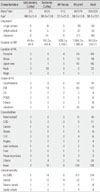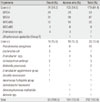1. ESRD Registry Committee. Korean Society Nephrology. Current renal replacement therapy in Korea: Insan memorial dialysis registry, 2009. Korean J Nephrol. 2010. 29:Suppl 2. S525–S551.
2. National Kidney Foundation. Clinical practice guidelines and clinical practice recommendations 2006 updates: hemodialysis adequacy, peritoneal dialysis adequacy, vascular access. Am J Kidney Dis. 2006. 48:Suppl 1. S1–S322.
3. Vascular Access 2006 Work Group. Clinical practice guidelines for vascular access. Am J Kidney Dis. 2006. 48:Suppl 1. S176–S247.
4. Pearson ML. The Hospital Infection Control Practices Advisory Committee. Guideline for prevention of intravascular device-related infections. Part I. Intravascular device-related infections: an overview. Am J Infect Control. 1996. 24:262–277.

5. Bone RC, Balk RA, Cerra FB, Dellinger RP, Fein AM, Knaus WA, Schein RM, Sibbald WJ. The ACCP/SCCM Consensus Conference Committee. American College of Chest Physicians/Society of Critical Care Medicine. Definitions for sepsis and organ failure and guidelines for the use of innovative therapies in sepsis. Chest. 1992. 101:1644–1655.

6. Cook RJ, Ashton RW, Aughenbaugh GL, Ryu JH. Septic pulmonary embolism: presenting features and clinical course of 14 patients. Chest. 2005. 128:162–166.
7. Lafrance JP, Rahme E, Lelorier J, Iqbal S. Vascular access-related infections: definitions, incidence rates, and risk factors. Am J Kidney Dis. 2008. 52:982–993.

8. Saeed Abdulrahman I, Al-Mueilo SH, Bokhary HA, Ladipo GO, Al-Rubaish A. A prospective study of hemodialysis access-related bacterial infections. J Infect Chemother. 2002. 8:242–246.

9. Lee T, Barker J, Allon M. Tunneled catheters in hemodialysis patients: reasons and subsequent outcomes. Am J Kidney Dis. 2005. 46:501–508.

10. Qasaimeh GR, El Qaderi S, Al Omari G, Al Badadweh M. Vascular access infection among hemodialysis patients in Northern Jordan: incidence and risk factors. South Med J. 2008. 101:508–512.

11. Kessler M, Hoen B, Mayeux D, Hestin D, Fontenaille C. Bacteremia in patients on chronic hemodialysis. A multicenter prospective survey. Nephron. 1993. 64:95–100.
12. Minga TE, Flanagan KH, Allon M. Clinical consequences of infected arteriovenous grafts in hemodialysis patients. Am J Kidney Dis. 2001. 38:975–978.

13. Lee SJ, Cha SI, Kim CH, Park JY, Jung TH, Jeon KN, Kim GW. Septic pulmonary embolism in Korea: Microbiology, clinicoradiologic features, and treatment outcome. J Infect. 2007. 54:230–234.

14. Dhingra RK, Young EW, Hulbert-Shearon TE, Leavey SF, Port FK. Type of vascular access and mortality in U.S. hemodialysis patients. Kidney Int. 2001. 60:1443–1451.

15. Oliver MJ, Rothwell DM, Fung K, Hux JE, Lok CE. Late creation of vascular access for hemodialysis and increased risk of sepsis. J Am Soc Nephrol. 2004. 15:1936–1942.

16. Danese MD, Griffiths RI, Dylan M, Yu HT, Dubois R, Nissenson AR. Mortality differences among organisms causing septicemia in hemodialysis patients. Hemodial Int. 2006. 10:56–62.

17. Li Y, Friedman JY, O'Neal BF, Hohenboken MJ, Griffiths RI, Stryjewski ME, Middleton JP, Schulman KA, Inrig JK, Fowler VG Jr, Reed SD. Outcomes of
Staphylococcus aureus infection in hemodialysis-dependent patients. Clin J Am Soc Nephrol. 2009. 4:428–434.

18. Taylor G, Gravel D, Johnston L, Embil J, Holton D, Paton S. Canadian Hospital Epidemiology Committee. Canadian Nosocomial Infection Surveillance Program. Prospective surveillance for primary bloodstream infections occurring in Canadian hemodialysis units. Infect Control Hosp Epidemiol. 2002. 23:716–720.

19. Hoen B, Paul-Dauphin A, Hestin D, Kessler M. EPIBACDIAL: a multicenter prospective study of risk factors for bacteremia in chronic hemodialysis patients. J Am Soc Nephrol. 1998. 9:869–876.

20. McCarthy JT, Steckelberg JM. Infective endocarditis in patients receiving long-term hemodialysis. Mayo Clin Proc. 2000. 75:1008–1014.







 PDF
PDF ePub
ePub Citation
Citation Print
Print






 XML Download
XML Download